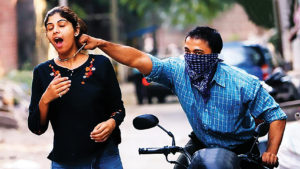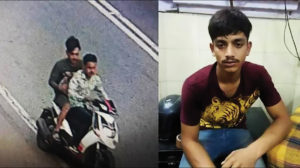Delhi Police seem helpless about the alarming rise in incidents of snatchings by bike-borne youngsters – about 17 per day – but Mumbai Police was able to stem the tide
In Sadar Bazar, one of the most hustling-bustling areas of New Delhi, a small colony Basti Julian seems to go silent when enquiries are made about a certain Gaurav aka Nonu, who was a former resident of the area. “Humein unse koi matlab nahi” (We have nothing to do with him), says one of the residents. The resident then points out that Nonu and his family moved from their area five years ago, to the nearby Motia Khan area, some 2 km from the current area.
This is the same person who was one of the two snatchers arrested in the recent case of the purse- snatching incident that happened with Damayanti Ben Modi, the niece of Prime Minister Narendra Modi, in front of the Gujarat Niwas in the Civil Lines area. Two scooter-borne men snatched Damayanti’s purse containing Rs 56,000 in cash and mobile phones and fled from the spot at around 7 am.
A total of 700 policemen were then divided into multiple teams to nab the suspect of this high-profile snatching incident. Seeing CCTV footage from multiple sources, the police identified the scooter used to conduct the crime. The miscreants were not wearing helmets and therefore it was easy to identify their faces. Police then identified one of the victims as Nonu, and then began a widespread search for him and his associate, Badal.
During the searches in Nabi Karim, Sadar Bazar, and Uttam Nagar – all places where both the accused had lived at some point or another. The police then caught hold of Nonu’s relatives, who revealed that he might be hiding at his in-laws’ place in Sonepat, Haryana.
DCP (North) Monika Bhardwaj said a case under IPC Sections 356 (assault or criminal force in attempt to commit theft) and 379 (theft) has been registered at Civil Lines police station
Nonu, a school dropout, was unemployed. He was also addicted to drugs and was involved in petty crimes like theft from a very young age. He was born in Nabi Karim but moved out after their father’s death. His mother remarried and they moved to Sadar Bazar. His drug addiction saw many of his family members sever their relationship with them.

In the dingy lane of Motia Khan where the previous resident pointed out Nonu’s current address, the people refused to speak a word about him. “We are tired of telling cops and court officials about Nonu and his family. We knew that he was upto no good, and that is why all of us in the mohalla used to avoid him”, said an elderly resident of the area. All the residents that Patriot spoke to were reticent and refused to divulge any details about Nonu or his family’s whereabouts.
As per the Crime in Delhi Report of 2018, 96.66 per cent of the total arrested criminals were first-time offenders and 54.90 per cent of them were illiterate or school dropouts.
Fairly recently, near Vinoba Puri metro station in Lajpat Nagar, three men on a motorcycle snatched a man’s mobile phone, and fled towards AIIMS. The police then nabbed these three criminals the next day. During investigation, it was revealed that the leader of this gang, Naresh Kumar, was a school dropout and all three of them were unemployed.
On August 7, two snatchers were arrested after they fled with a person’s mobile phone near Sector 9. Both of the arrested were school dropouts and had resorted to drug and alcohol addiction.
“Most of the snatchers are first-timers. They see it as a crime of opportunity, since it is an easy crime,” says Anil Mittal, Addl PRO of Delhi Police.
This leads to a problem, as it is difficult for the police to identify and track and these first- timers. Looking for ways to make quick money, they start off by snatching chains and wallets and often graduate to bigger crimes.
Pointing out that they mostly come from low income backgrounds he adds, “They do it because their expenditure is high and their income is not enough to meet their needs.”
Mittal also mentions that most of the snatchers come from the lower rungs of the social strata, mostly people living in slums and jhuggis.
According to the police, stringent action is being taken against robbers and snatchers with constant monitoring of criminals released from jail by keeping a check upon their whereabouts so as to ensure that they do not indulge in criminal activity repeatedly. Along with this, Delhi Police is also ensuring dynamic picketing with integrated checks with PCR and Traffic Police at vulnerable hotspots to keep a check on the movement of criminals. Foot patrolling is being ensured by officers and men alike during these patrols.

To reduce more people going into a life of crime, Delhi Police in 2017 launched an initiative titled Yuva. Herein, the police took up youngsters who were juvenile miscreants, school dropouts, drug addicts or belonging to a criminal family under their wing. These people are then trained in various skills like smartphone repairing, tailoring and make-up so that they are gainfully employed.
More than 5,000 people have been trained under this initiative and 2,500 now have jobs, says official Delhi Police data.
However, the statistics do not paint such a rosy picture. The number of snatching cases in the city has already gone up to 4,762 till September this year, which implies approximately 17 cases per day. As per police data, 11 snatchers have been arrested in last 3-4 days. When compared to that of last year, the total number of cases in 2018 was 6,642 out of which 3,785 were solved.
With several cases of snatching reported across the city every day, it is quite common for auto-rickshaw drivers to warn their passengers of motorcycle-borne snatchers and to keep their belongings safe.
While the total number of snatchings remains alarming in the Capital, Mumbai has seen a dramatic decline in chain-snatching cases, with an almost 92% dip. The police identified a total of 70 vulnerable locations in the city which had the greatest number of chain-snatching incidents. Deploying preventive patrolling and surveillance of habitual offenders, these locations were monitored. Along with these, additional police personnel on motorcycles were deployed during morning and evening peak hours.
The same was done in Coimbatore, where patrolling has been increased in vulnerable locations at 5-8 am and 5-9 pm. The police stations have collected details of history-sheeters involved in snatching in the last five years.
Perhaps it’s time Delhi Police learns a lesson or two from them.





